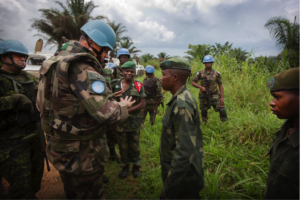How Has the Genocide Lead to Continued Violence in the Democratic Republic of Congo Today
by Herman J. Cohen
Editor ' s Note: American Diplomacy Journal asked several foreign policy commentators to address the significance of growing chaos in many parts of the world, as failed and failing states are increasingly unable to perform the fundamental functions of the sovereign nation- state. This is one of five articles looking at those concerns.
Because of its vast size, about equal to the U.S. east of the Mississippi, and its large deposits of strategic minerals, the Democratic Republic of the Congo is of special interest to American and western national security. In the current rush to develop renewable energy, for example, the minerals cobalt and lithium are essential. The DRC is the most important source of these minerals outside of Russia. The DRC is also one of the few countries that produces columbite and tantalum that are necessary for the world's portable phones. The DRC is also host to the second largest tropical rain forest in the world after the Amazon. Preservation of this carbon sink is essential to the worldwide effort to limit global warming. The maintenance of stability in the DRC, a country that has seen long periods of instability in its sixty-year history, is therefore an international priority.
With the end of the Kabila regime in the Democratic Republic of the Congo came new hopes for peace and progress in one of Africa's most historically violent and corrupt nations. Yet since President Felix Tshisekedi's administration formally assumed power in January 2019, the eastern DRC has seen thousands of murders and kidnappings, in a dramatic escalation of violence.
The second quarter of 2021 was the deadliest in recent history, according to the nonprofit Kivu Security Tracker: 564 killings over just the past three months. Hundreds of discrete militias and insurgencies operate in the area – rendering a negotiated settlement unlikely – but the single worst offender is the Allied Democratic Forces (ADF), a decades-old Ugandan group responsible for 37% of civilian killings, far more than any other faction.
President Tshisekedi pledged to "definitively exterminate" the ADF during a "final offensive" shortly after his inauguration, but so far this initiative has been met with failure, while massacres and other human rights abuses increase in frequency and brutality.
With international aid dwindling under pandemic pressures, how can the Tshisekedi administration rein in the ADF and other militant groups, and get the violence under control? Insurgencies can be intractable even for the world's largest and best equipped militaries. But Congo's militants have three unique advantages: a steady source of finance, infighting in Congo's civilian government, and corrupt allies in the Congolese armed forces (FARDC).
Gold, Death, and Taxes
Ideological motives for the insurgents are obscure. The ADF, for instance, is ostensibly an Islamist jihadist group, but its roots are more political in nature. The U.S. has accused the ADF of merely being an Islamic State affiliate, calling it "ISIS-DRC", but prominent analysts strongly disagree that it has any substantive ties to IS, and U.N. Security Council experts have found no corroborating evidence. Where IS is an expansionist organization that envisions a global caliphate, as the ADF "African Arguments" article put it, sources state that the ADF primarily wants to be left alone, and "its main message to local populations is that it will stop conducting mass killings when the army halts operations against it."

Instead, much of the violence is self-evidently motivated by loot. Informal "taxation," including at impromptu roadblocks, is one key source of funding. But the Congo's mineral wealth is the steadiest and most plentiful source of revenue. Gold is the single largest moneymaker: between $300 and $600 million in gold is smuggled out of the DRC each year, some of which ends up in supply chains of major Western companies, like Amazon, Sony, and GE. Unlike the large-scale industrial mining of the southern Katanga area, the northeastern DRC's mining is small-scale and artisanal, and ripe for exploitation by small armed groups. Militants thoroughly control the lucrative mining of coltan, lithium, tin, tantalum, and tungsten there. Some of the activity is even directed by entrepreneurs in neighboring Rwanda, Uganda, and Sudan, who help to finance militant operations at the mines in return for a share of the profit.
U.S. institutions have a role to play in preventing Congolese militants from profiting via products sold here. The 2010 Dodd-Frank financial reform bill requires all publicly traded companies in the U.S. to disclose whether any of the gold or 3T minerals used in their products originated in Congo or a neighboring country, and if so, to report their due diligence on sourcing, but it does not require them to source from conflict-free mines or to stop sourcing from the DRC altogether. A joint USAID-State Department "conflict minerals strategy" was developed around the same time, but there are no performance indicators to track how well it is working. Clearly, there are opportunities for improvement in both the public and private sectors.
Military Collusion
The Congolese government and military have been perhaps the most stubborn obstructions to overpowering the militants. Tshisekedi's transition to the presidency was accomplished through a power-sharing bargain with outgoing President Kabila, who corruptly retained control over parliament and key levers of government. Kabila's faction obstructed Tshisekedi's attempts to organize regional militaries and international bodies against militant groups. But last December, Tshisekedi finally wrested power from Kabila's FCC party and installed his own cabinet, including a new defense minister that answers to him instead of Kabila.
In May, Tshisekedi declared a "state of siege" in North Kivu and Ituri provinces, temporarily replacing civilian administrators with military officials in the hope of regaining central control of the region. But the military is part of the problem. The FARDC is a thoroughly corrupt institution, commanded by a "military bourgeoisie" that benefits financially from continued violence and is concerned more with patronage than security. Besides its own history of extrajudicial killings, rapes, and illegal mining, there is extensive evidence of direct collusion between Congolese military officials and militants, including the ADF.
Top FARDC officers employ another notorious militant group – the NDC-Rénové, which holds more territory than any other faction – as a proxy force in their operations, while colluding in their mining and racketeering businesses. As the NDC-R commits village burnings, murders, and sexual slavery, it works so closely with the FARDC that, according to the Congo Research Group, NDC-R members often wear FARDC uniforms and freely move in FARDC-held areas.
A serious solution to the violence in the eastern DRC will need to start with reform of the military. Corrupt commanders must be replaced by a younger generation of officers, thoroughly vetted and trained abroad, with better salaries to discourage graft. Mechanisms for accountability must be established, like the judiciary measures proposed by Human Rights Watch, which could also help to demobilize and integrate former rebels into the FARDC.
Unfortunately, even with the cabinet finally under his control, Tshisekedi and his administration may not have the influence necessary to reshape the powerful military elite, which has spent decades refining its corruption while insinuating itself into Congolese governance. Reform may have to wait until the presidential elections scheduled for 2023. If President Tshisekedi is re-elected with a strong majority, he may have a mandate to implement the profound changes needed to fix Congo's military, and thus put down the militant violence in the country's east.
The United States has been heavily involved in the DRC's security ever since law and order collapsed in the first days of the nation's independence from Belgium in 1960. American military have never been engaged in combat operations in the DRC, but have been involved in providing logistics, equipment and advice. At the present time, when the Tshisekedi government is finding it almost impossible to cope with violence in the northeast, it is in the strategic interest of the United States to offer its expertise in counterterrorism, as well as exert its influence with the UN peacekeeping force, MONUSCO.
MONUSCO, United Nations Organization Stabilization Mission in the Democratic Republic of the Congo, was established in the year 2000 to assist in organizing ceasefires, disarmament, and the reorganization of the DRC military. It also has the mandate to protect UN personnel and property. In view of the inability of the DRC military to stop the various militias in the northeast from murdering innocent Congolese villagers, the UN Security Council in 2020 expanded and renewed MONUSCO's mandate until December 2021. The mandate includes protection of civilians and support for strengthening public institutions, as well as a gradual exit strategy.
In the final analysis, immense wealth is being generated in the Congo's northeastern provinces while most of the population in the region is living below the poverty line. It should not be surprising, therefore, that young men are joining militias and are taking over mining properties. The DRC Government is earning revenue through royalties, but the population is seeing little benefit in terms of improved health facilities, better education, and new infrastructure. The net result is an erosion of government authority in one of Africa's largest and most significant countries. The DRC experience is visible in other African nations that enjoy strong export earnings, including Angola, Mozambique, Cameroon, Nigeria, and Ethiopia.
The decline in government authority over the years in many African nations since independence is certainly not what the former colonial powers envisaged. The British, French and Portuguese expected their former colonies to evolve as parliamentary democracies similar to themselves, despite doing little to facilitate it. However, the former colonial masters did not foresee the overwhelming impact of cultural factors, especially ethnicity and the power of families, or recognize the weakness of institutions they had left behind.![]()

Herman J. "Hank" Cohen was in the United States Foreign Service for 38 years where he specialized in U.S.-Africa relations. His assignments included Ambassador to Senegal and the Gambia, Senior Director for Africa on the National Security Council under President Reagan, and Assistant Secretary of State for African Affairs under President George H.W. Bush. His most recent book is "U.S Policy Toward Africa: Eight Decades of Realpolitik", Lynne Rienner, 2020.
Source: https://americandiplomacy.web.unc.edu/2021/08/dealing-with-violence-in-the-democratic-republic-of-the-congo/
0 Response to "How Has the Genocide Lead to Continued Violence in the Democratic Republic of Congo Today"
Post a Comment